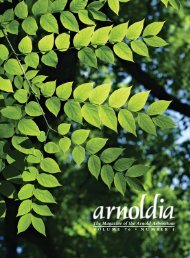The Brenton Arboretum: A Personal Story
Buz Brenton's memoir of the early years of The Brenton Arboretum in Dallas County, Iowa.
Buz Brenton's memoir of the early years of The Brenton Arboretum in Dallas County, Iowa.
You also want an ePaper? Increase the reach of your titles
YUMPU automatically turns print PDFs into web optimized ePapers that Google loves.
corporation, whereby we could use about one half acre to plant these trees in rows. <strong>The</strong> agreement<br />
with Iowa State University and LPDC specified that we would plant and maintain the trees, which<br />
they would help us select and evaluate over a ten-year period. Jeff Iles, our board member, and<br />
Harold Pellett, founder and head of LPDC, were our partners. My brother Bob and his son Bill,<br />
officers of <strong>Brenton</strong> Brothers, Inc., graciously let us use their land for this evaluation.<br />
Why did the arboretum enter the conifer research project? <strong>The</strong> answer is simple. Early on, it<br />
seemed that the public might benefit from some sort of research or evaluation project at the<br />
arboretum. <strong>The</strong> board agreed with the concept. I felt that tree evaluation and research could lead to<br />
a public service (research is in our mission statement). It also could lead to our becoming a more<br />
serious member of the larger botanical garden and arboretum community. We, in short, needed to<br />
do serious evaluation that could be scientifically conducted with careful record keeping as to<br />
provenance and growth characteristics. We could set ourselves apart in a tangible way from many<br />
institutions if we carefully recorded and published what we found. With ISU and the LPDC as our<br />
partners, we would (and did) maintain thorough records with careful evaluation and were able to<br />
publish some of our findings. This is why we got into the research business: to be taken seriously as<br />
an institution by our peers as well as to perform a public service.<br />
Our board felt that conifer research was a good fit because of the scarcity of conifers<br />
growing as natives in central Iowa, the health problems with some commonly used species (scotch<br />
and red pine for example), and, in our opinion, the over reliance on several very common species<br />
such as eastern white pine.<br />
<strong>The</strong> ideas was that if we could<br />
demonstrate over ten years the livability,<br />
under harsh conditions, of certain littleused<br />
conifer species, they might find their<br />
way into general use. If we could publicize<br />
this information, we could increase the<br />
variety of conifers planted and decrease the<br />
vulnerability of reliance on just a very few<br />
species.<br />
We decided to focus our conifer<br />
research on the species in the table to the<br />
right, which were the recommendations of<br />
Jeff Iles and Harold Pellett.<br />
<strong>The</strong> third significant change began<br />
in the spring of 2002, when our educational<br />
program began to take root. Education<br />
about trees, the natural world, and its interconnectedness is part of our mission and central to what<br />
we want to do. Nowhere is this more important than with young schoolchildren. With Anne<br />
60




